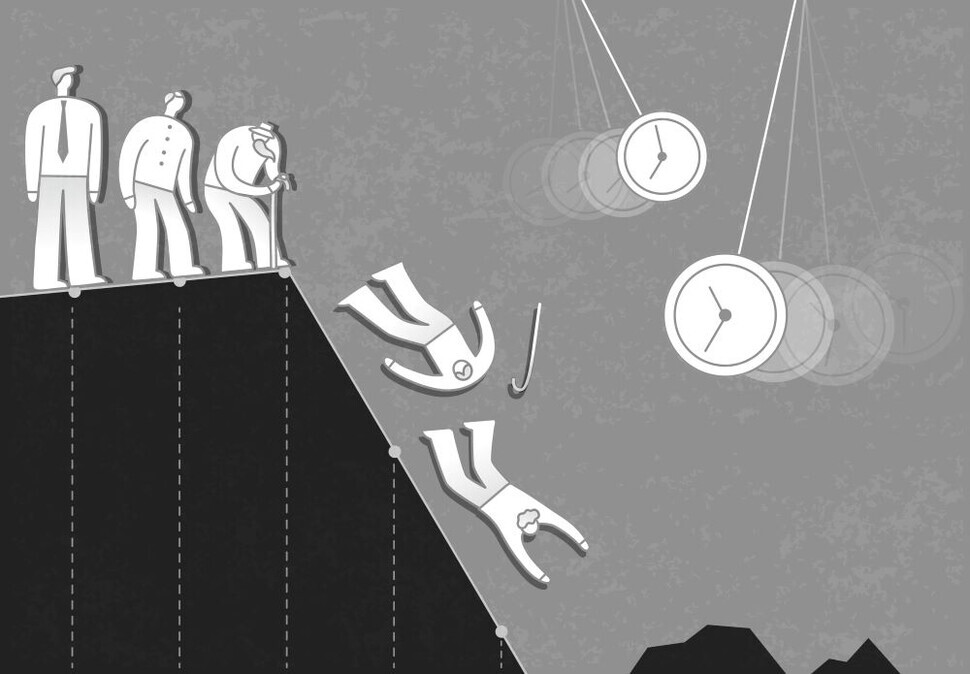hankyoreh
Links to other country sites 다른 나라 사이트 링크
In 50 years, half of Koreans are expected to be 65 or older

After hitting its peak in 2020, the South Korean population is forecast to drop to 36 million in 50 years. Chronically low birth rates are expected to drop the total fertility rate to below the previously inconceivable threshold of 0.7 births per woman by next year. In 50 years, those 65 and older are expected to comprise half of Korea’s population. A grim forecast for Korea, some have likened this coupling of plummeting fertility and an aging society to the Black Death, while others are calling it a “mass suicide.”
According to a report on population trends published by Statistics Korea on Thursday, South Korea’s population came to 51.67 million in 2022, which slightly increased to 51.71 million in 2023. However, by 2072, it’s expected to drop to 36.22 million. This would mean a 30% decrease (15.45 million people) in just 50 years.
South Korea’s population peaked in 2020 at 51.84 million people. This means we’ve already passed the critical “death cross,” the point where deaths start outnumbering births. Statistics Korea points to an influx of foreign residents to explain this year’s slight population jump from last year. The population is expected to increase slightly until 2024 before falling again in 2025.
Low birth rates are causing the nation’s population to decrease at a continually accelerating rate. The total population is expected to fall below 50 million in 2041 and below 40 million by 2065. South Korea’s total fertility rate (the number of children that one woman is expected to have in her entire lifetime) fell from 0.78 in 2022 to 0.72 this year, and is expected to fall to 0.68 in 2024. It’s expected to plummet to 0.65 by 2025 before rising to 1.08 in 2050.
Just two years ago, Statistics Korea predicted that South Korea’s total fertility rate would be 1.21 in 2050. A significant downward adjustment in just two years reflects the severity of declining birth rates. When accounting for the gender ratio and infant mortality rates, the total fertility rate needs to be at least 2.1 to maintain the current population.
“A total fertility rate of 1.08 is the lowest in the world,” said Lim Young-il, director of Statistics Korea’s vital statistics division.
“This is significantly lower than 1.3, which is the OECD’s standard for an ultra-low fertility rate,” Lim said.
South Korea’s population pyramid, a graphical illustration of a population’s distribution according to age groups and sex, shows that the current bulk of the nation’s population falls in the 30-50 age group. However, this cohort is expected to be eventually replaced by people aged 60 and above, resulting in an inverse pyramid. The working-age population, people aged 15 to 64, was 36.74 million in 2022, but is expected to diminish to 29.55 million by 2039 and plummet to 16.58 million by 2072.
Conversely, the proportion of people aged 65 and above is expected to increase from 17.4% in 2022 to 47.7% in 2072. This means nearly half of the population will be nearing or past retirement age. The dependency ratio, which measures the number of people outside the working-age population per 100 working-age people, is expected to skyrocket from 40.6 in 2022 to 118.5 in 2072. While the median age is expected to be 49.7 in 2030, by 2072, it’ll have skyrocketed to 63.4.
Such estimates were drawn according to the available data for recorded fertility rates, life expectancy, and the influx of foreign residents, and represent the most likely scenarios. Statistics Korea forecast that the population will fall to around 30.17 million in 2072 and to 10.85 million in 2122.
By Park Jong-o, staff reporter
Please direct questions or comments to [english@hani.co.kr]

Editorial・opinion
![[Editorial] Yoon must halt procurement of SM-3 interceptor missiles [Editorial] Yoon must halt procurement of SM-3 interceptor missiles](https://flexible.img.hani.co.kr/flexible/normal/500/300/imgdb/child/2024/0501/17145495551605_1717145495195344.jpg) [Editorial] Yoon must halt procurement of SM-3 interceptor missiles
[Editorial] Yoon must halt procurement of SM-3 interceptor missiles![[Guest essay] Maybe Korea’s rapid population decline is an opportunity, not a crisis [Guest essay] Maybe Korea’s rapid population decline is an opportunity, not a crisis](https://flexible.img.hani.co.kr/flexible/normal/500/300/imgdb/original/2024/0430/9417144634983596.jpg) [Guest essay] Maybe Korea’s rapid population decline is an opportunity, not a crisis
[Guest essay] Maybe Korea’s rapid population decline is an opportunity, not a crisis- [Column] Can Yoon steer diplomacy with Russia, China back on track?
- [Column] Season 2 of special prosecutor probe may be coming to Korea soon
- [Column] Park Geun-hye déjà vu in Yoon Suk-yeol
- [Editorial] New weight of N. Korea’s nuclear threats makes dialogue all the more urgent
- [Guest essay] The real reason Korea’s new right wants to dub Rhee a founding father
- [Column] ‘Choson’: Is it time we start referring to N. Korea in its own terms?
- [Editorial] Japan’s rewriting of history with Korea has gone too far
- [Column] The president’s questionable capacity for dialogue
Most viewed articles
- 1Months and months of overdue wages are pushing migrant workers in Korea into debt
- 2[Guest essay] Maybe Korea’s rapid population decline is an opportunity, not a crisis
- 3Under conservative chief, Korea’s TRC brands teenage wartime massacre victims as traitors
- 4Dermatology, plastic surgery drove record medical tourism to Korea in 2023
- 5[Column] Can Yoon steer diplomacy with Russia, China back on track?
- 6First meeting between Yoon, Lee in 2 years ends without compromise or agreement
- 71 in 3 S. Korean security experts support nuclear armament, CSIS finds
- 8At heart of West’s handwringing over Chinese ‘overcapacity,’ a battle to lead key future industries
- 9[Editorial] Japan’s rewriting of history with Korea has gone too far
- 10[Editorial] Yoon must halt procurement of SM-3 interceptor missiles